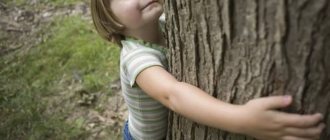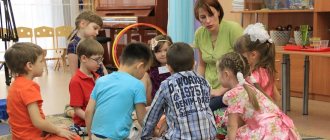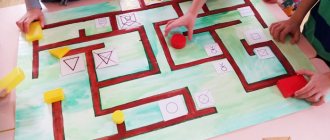Formation of aesthetic feelings in preschool age
Aesthetic education is not innate. It begins to form in early childhood in a social environment. Active and competent pedagogical leadership is critical to the development of aesthetic sensitivity. In the process of aesthetic development, children gradually master the basics of aesthetic culture, aesthetic perception, ideas, concepts, interests, judgments, needs, feelings, creativity and artistic activity. The dynamics of the formation of aesthetic sensitivity and the formation of aesthetic culture involves the passage of several stages directly related to the developmental characteristics of a child at a certain age.
It is advisable to consider the features of early childhood development as a propaedeutic period towards aesthetic acceptance of the surrounding world. This stage begins with the formation of sensory sensitivity and subsequent emotional “reaction” to acquaintance with the most striking qualities and characteristics of objects that surround the child. From early childhood he pays attention to everything beautiful, bright, colorful and shiny. Aesthetic perception of the environment has its own specific characteristics. For a child, the most important thing is the sensory form of things, namely their shape, color, sound, smell. Therefore, the aesthetic education of a child requires a certain level of development of sensory culture.
The child perceives beauty as the unity of content and form. Form is the unity of lines, sounds, colors. But an aesthetic child can perceive only when the perception is emotionally charged, because aesthetic appreciation is closely related to feelings and emotions. Aesthetic feelings are distinguished by the fact that they are accompanied by an encounter with the beautiful light of spiritual excitement and selfless joy. Thus, we can conclude that an important component in the formation of aesthetic feelings is the emotional reaction to the perceived object. But the full formation of aesthetic feelings cannot occur with an abstract, “passive” perception of reality.
Activities in preschool age are also important for the formation and development of aesthetic feelings. At an early age, techniques for imitation of various types of primitive games and artistic activities are formed, and a feeling of satisfaction develops not so much from performing the activity, but from the achieved result.
The development of language contributes to the assimilation of the names of a much larger number of reference signs, aesthetic qualities through comparison: dirty - clean, small - big, sad - cheerful, ugly - beautiful, etc.
It is necessary to pay attention to the fact that in most cases preschoolers cannot separate the concepts of “correct” and “beautiful”, which has great potential for the implementation of both moral and aesthetic educational tasks. In preschool age, aesthetic education of children is carried out by parents “intuitively” rather than purposefully. But at the same time, aesthetic education in the family plays an important role in the aesthetic development of a preschool child and the formation of his personality, despite the fact that parents do not have pedagogical and methodological skills. In the family, family traditions are the basis of aesthetic education, ensuring continuity between generations, the formation of aesthetic values, role models and experience. Therefore, it is also important to carry out explanatory and methodological work with parents of preschool children on aesthetic education.
In the conditions of a preschool educational institution, subsequent changes occur in the aesthetic development of the child. The child becomes more receptive to certain elements of art form, such as color, rhythm and rhyme. Children also begin to react differently to the work itself. Their motivation to evaluate a work of art is secular or subjective. Young children usually notice individual features of a phenomenon, express their thoughts briefly and sometimes use very specific assessments.
How to introduce children to art?
To be able to understand art is not an innate quality, but an educated one.
Advice. You need to teach your child to understand classical music, dance, and theater gradually and carefully. Otherwise, you can become disgusted with the incomprehensible actions of the artists.
In order for a preschooler to easily perceive the classics, he needs to hear them from early childhood. You need to select classics for kids and include them infrequently. When the baby turns 3-4 years old, you can already try to discuss what you heard, talk about music and musical instruments.
It’s best to start getting acquainted with painting by looking at reproductions in art albums. Pictures should be selected taking into account the child’s age: images of fairy tale plots, animals, and fairy-tale characters that are understandable to him.
You can even take a 1.5-year-old baby to the theater. Puppet theaters always have performances for the little ones. The performances last no more than 30 minutes, and the child does not have time to get tired.
It is better to visit museums from 4-5 years old. It would be better if these were children's themed museums or exhibitions. It is better to start going to the children's philharmonic and ballet from the age of 5, choosing children's performances and concerts.
Before visiting a theater or museum, explain to your child that you are going to an important place and how to behave there. Feed your child before going to a museum or theater so that the feeling of hunger does not distract your child from interesting things. Make sure that the road to the abode of the muses is not long and tiring, dress your baby beautifully and let him feel the importance of the event. Be sure to ask the baby about his impressions of what he saw and heard. Ask if he would like to see something interesting again. If the child is not delighted, take a break and try to organize cultural leisure again after some time.
Objectives of aesthetic education of preschool children
Full and harmonious physical and intellectual development, a hierarchy of values, a moral assessment of reality and an active life position determine a comprehensively developed personality, the moral component of which depends primarily on aesthetic education. The kindergarten teacher must help children move from the perception of beauty and emotional reaction to objects of aesthetic feelings to understanding, to the formation of aesthetic concepts, opinions, ideas, assessments, to the formation of a scale of value relations. Aesthetic education is the painstaking work of the educator, which should be carried out unobtrusively and systematically in order to teach children to aesthetically perceive the world around them, experience it, change it, teach them to create a common system of aesthetic norms and experiences, which should become the basis of an aesthetic culture necessary for the harmonious development of the personality of a preschooler. , like all other personal qualities.
The goal of aesthetic education is to develop in children the ability to see the beauty of the life around them and create and transform it. Based on the goal, the tasks of aesthetic education can be divided into two groups.
The development of aesthetic perception, artistic and aesthetic skills, and activity is based on the development of sensory systems at the required time, the work of various analyzers capable of providing the necessary accuracy and subtlety of discrimination.
When performing aesthetic education tasks, children develop such personal qualities as initiative, anticipation of results, desire for them, and the ability to dream. Therefore, the first group of tasks is aimed at developing the aesthetic attitude of preschoolers to the surrounding reality. This group includes tasks that contribute to the development of aesthetic consciousness and perception of preschool children. The following tasks can be distinguished:
- Formation and development of sensory perception;
- Developing the ability to see, understand and feel the aesthetic beauty of nature, human actions and art.
- Familiarization with the system of reference qualities and personality traits, with the gradual inclusion of these names in the active dictionary of preschoolers;
- Give preschool children knowledge about beauty;
- The formation of aesthetic knowledge and judgments, ideas and concepts, which in turn determine aesthetic tastes and assessments, needs and interests;
- Formation and development of aesthetic emotions and feelings in preschool children: The ability to react emotionally to the beautiful and ugly, funny and sad, etc.
- Development of artistic taste, desire and need to study beauty.
Certain tasks require their solution using appropriate tools and methods. As A.S. believed Makarenko, methods are a means of influencing a person, ways by which a targeted pedagogical influence on the consciousness and behavior of students occurs. To complete the tasks of the first group, it is advisable to use methods such as observation, demonstration, example of an adult, and analysis.
The method of exposure is actually found in the first meeting and acquaintance with the subject of aesthetic reality. The teacher must think through the object of the demonstration and organize the lesson so that the children's attention is focused on what they see or hear. When implementing this group of methods, the teacher must be able to express his feeling, his attitude, he must be able to express his feelings in different ways, for example, expressiveness when reading a poetic work, sincere admiration for a beautiful thing or sincere disappointment from carelessness in clothing. The ability of an adult to clearly express his feelings and emotions is an active method of influencing a preschooler, since it is based on imitation of childhood.
Principles of aesthetic education
Aesthetic education of preschool children is carried out in accordance with the principles of modern pedagogy. Accordingly, aesthetic education, its forms, methods and means must correspond to the main goal - the education of a comprehensively developed, active, socially interested person, possessing not only the rudiments of aesthetic judgment and feeling, but also a high degree of aesthetic culture.
It is convenient to emphasize the basic principles underlying modern concepts of aesthetic education.
1) The principle of continuity
First of all, this is the principle of continuity of cultural components of aesthetic education of preschool children. This principle presupposes an inextricable connection between folk aesthetic culture, modern art and the best traditions of the past with the basic principles of aesthetic education.
2) The scientific principle
The scientific principle in aesthetic education should be based on a clear vision, analysis of what has been achieved, predictable results and a direct connection with goals that are significant to society. This principle implies the acquisition by the younger generation of strictly scientific knowledge in accordance with the characteristics of modern art and the stage of its development.
3) The principle of systematicity and programming
The principle under consideration assumes consistency and uniformity in the acquisition of knowledge, skills and aesthetic education in accordance with the age level of development and the use of content, forms and methods of teaching.
4) Principle of complexity
The principle of complexity of aesthetic education should be associated with the harmonious, holistic development of personality, which should be carried out in two directions. First, aesthetic development influences the formation of a child's personality and the development of certain aspects of personality, qualities and abilities. Secondly, the very formation of the personality of a preschool child has a significant impact on his system of values, views, norms and ideas, which at the same time have aesthetic properties.
5) Principle of unity
The principle of the unity of learning and development of the creative potential of preschool children assumes a close relationship between learning and the formation of independent artistic creativity in children. These processes are not considered separately, since creativity is formed in the process of acquiring knowledge, skills and abilities in education, and education brings great results when creative abilities are considered.
The interaction of the creative and educational components varies depending on the educational task: the less mastered the subject, the simpler the creative element; The better a subject is mastered, the wider the field of its combination with creative tasks.
The main way of aesthetic development of a preschool child is the development of his creativity and independent artistic activity. All the principles considered are closely related to each other and determine the direction and planning of the pedagogical process.
Development of creativity
Artistic activity (drawing, designing, making appliqués, modeling and other activities) lays the foundation for the formation of the ability to express oneself and reveal one’s creative abilities. Music, songs, and dances contribute to the development of a sense of rhythm, visual and auditory perception, and encourage the development of new actions and movements. They force you to fantasize, be attentive and diligent. Such activities distract from sad events, help relieve nervous tension, and lift your spirits.
Independent artistic activity allows preschoolers to realize their ideas and plans in artistic creativity. This is facilitated by:
- learning how to act independently;
- artistic impressions;
- correct aesthetic environment;
- encouragement from teachers and parents;
- indirect influence of the teacher.









